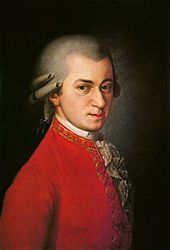Klaviersonate Nr. 17 (Mozart)

Die Sonate No. 17 in B-Dur KV 570 ist eine Klaviersonate von Wolfgang Amadeus Mozart in drei Sätzen. Sie gehört zu Mozarts späten Sonaten und entstand 1789. Sie ist vermutlich eine Auftragskomposition, nachdem Mozart im Mai des Jahres 1789 den Auftrag vom Preußischen Hof erhalten hatte, sechs einfache Sonaten zu schreiben.[1]
Zu dieser Sonate existiert eine hinzugefügte Violinstimme unsicherer Herkunft, welche im Jahr 1800 veröffentlicht wurde. Der Klavierteil ist in beiden Fassungen gleich.
Die durchschnittliche Aufführungsdauer der Klaviersonate beträgt ungefähr 18 Minuten.
Sätze
1. Satz: Allegro
Der Kopfsatz dieses lyrischen Stückes weist stilistisch zwei markante Ähnlichkeiten zum ersten Satz der Klaviersonate Nr. 12 auf: Der Themenkopf hat eine ähnliche Motivik und moduliert in der Durchführung nach Des-Dur. Die Spannung wird durch das zweite Thema gesteigert, zu dem das erste Thema im Bass mit G-Dur reagiert. Anschließend erscheint die Reprise durch eine Rückmodulation.
Die kunstvolle Vertauschung der Stimmen im ersten Satz, die Parallelen zu seiner späteren Papageno-Arie aus der Zauberflöte aufweisen, erinnern wie so oft in Mozarts Sonaten an seinem Zeitgenossen Joseph Haydn.
2. Satz: Adagio
Die Abschnitte des zweiten Satzes, einem Adagio in Es-Dur, drückt durch die Imitation eines Hornklanges eine meditative Abschiedsstimmung aus. Der Satz ist wie ein Rondo aufgebaut und deren c-moll-Stelle im Mittelteil, besonders Takt 14, steht in einem engen Zusammenhang mit seinem 24. Klavierkonzert KV 491.
3. Satz: Allegretto
Der dritte Satz ist ein Rondo in der Ursprungstonart B-Dur im Tempo allegretto mit der unregelmäßigen Form A–B–C–A. Das Ritornell zwischen B und C fehlt hier. Im Abschnitt C nehmen die Tonrepetitionen Teile des Fugatos aus der Ouvertüre zur Zauberflöte vorweg.
Weblinks
- Sonate in B KV 570: Partitur und kritischer Bericht in der Neuen Mozart-Ausgabe
- Piano Sonata No.17 in B-flat major, K.570: Noten und Audiodateien im International Music Score Library Project
- Aufnahme von Paavali Jumppanen im Isabella Stewart Gardner Museum (MP3-Format)
- Beschreibungen der Sonaten auf G. Henle Verlag Webseite
Einzelnachweise
License Information of Images on page#
| Image Description | Credit | Artist | License Name | File |
|---|---|---|---|---|
| This posthumous portrait of Wolfgang Amadeus Mozart was painted by Barbara Kraft at the request of Joseph Sonnleithner in 1819, long after Mozart died. Sonnleithner, who was making a "collection of portraits in oils of well-known composers" (Deutsch) wrote to Mozart's still-living sister Maria Anna ("Nannerl"), asking her to lend a picture to Kraft (a well-known artist working in Salzburg). Here is part of Nannerl's reply: ... her friend Councillor von Drossdick ... sent the artist to me to see all 3 of my pictures of Mozart, the one that was painted when he came back from the Italian journey is the oldest, he was then just 16 years old, but as he had just got up from a serious illness, the picture looks sickly and very yellow; the picture in the family portrait when he was 22 years old is very good, and the miniature, when he was 26 years old, is the most recent I have, I therefore shewed this one to the painter first; it seemed to me from her silence that is would not be very easy to enlarge it, I therefore had to shew her the family portrait and the other one, too. ... she wants to take her copy from the family portrait and introduce only those features from the small picture which make him look somewhat older than in the big picture." Deutsch identifies the three pictures as: "Perhaps" the portrait by Knoller, Milan 1773. 1 The family portrait by della Croce. A lost small version of the famous portrait by Joseph Lange. For present purposes, this implies that Kraft painted this with some basis to go on (and not completely out of her head, as the painter of this ridiculous picture did). Also, it tells us that Nannerl thought that the della Croce picture was "very good". | Deutsch, Otto Erich (1965) Mozart: A Documentary Biography . Stanford: Stanford University Press. | Barbara Krafft | Datei:Wolfgang-amadeus-mozart 1.jpg |
